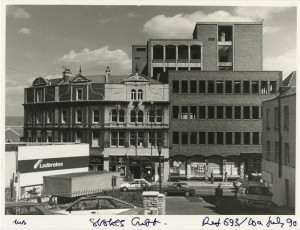John Trelawny-Ross: Conserving a city
Westmoreland House from Nine Tree Hill
Born in 1926, John Trelawny-Ross, the son of a clergy man, was brought up with his sister just outside of Plymouth. Later he went on to attend Sherborne School, and after that he carried out his national service in Greece and Palestine.
What followed next certainly paved the way for what proved to be his future career in the planning department of Bristol City Council. Firstly he studied architecture in London, before moving to the USA, where he met his wife and married in New York in 1959. It was here that his passion for architectural photography flourished as he drew inspiration from New York’s post war architecture.
After travelling the states, all the while enhancing his photography skills, he moved back to England, eventually residing in Clifton, Bristol, and joining the planning department of the city council.
The idea of architectural conservation in Bristol really began to take off in the 1970, and Trelawny-Ross, working alongside Dorothy Brown and Alistair Brook, as part of the ‘Town Scheme’ project, was instrumental in identifying the buildings in the city that required, and were worthy of, conservation. Particular attention was paid to protecting Clifton’s Bath stone terraces and their settings, which were, by the 1970s very much run down. It is thanks to this project, and these people, that so much of Bristol’s fine architecture is still available to be appreciated in all its glory today.
Following his death in 2013, his hugely extensive archive was deposited in Bristol Record Office, where it is kept in the correct climactic conditions so as to preserve the photographs for generations to come. Further to this, employees at the record office are in the process of, firstly digitising the photos, and then uploading them to the Know Your Place website, where they can be found on the Trelawny-Ross layer. Also helping with this project is John Trelawny-Ross’ grandson, Jon Ross-Elliot.
The practice of digitising archives is becoming increasing popular as, naturally it decreases the amount of handling there is of the documents and it decreases the amount of time documents spend outside of a stable environment, yet equally importantly, it increases their accessibility to the public on an international scale.
